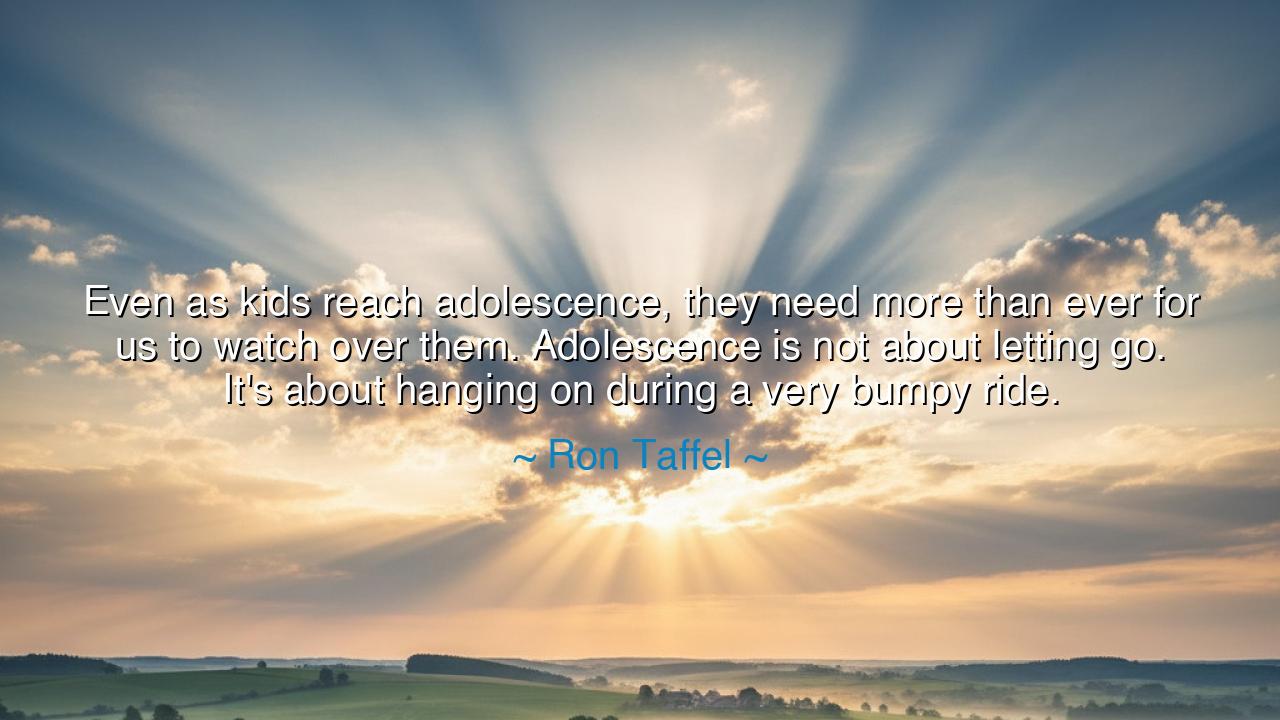
Even as kids reach adolescence, they need more than ever for us
Even as kids reach adolescence, they need more than ever for us to watch over them. Adolescence is not about letting go. It's about hanging on during a very bumpy ride.






In the words of Ron Taffel: “Even as kids reach adolescence, they need more than ever for us to watch over them. Adolescence is not about letting go. It’s about hanging on during a very bumpy ride.” These words shine with a clarity that pierces the illusions of modern thought. Too often do we believe that when children grow taller and speak with louder voices, they no longer require the guidance of elders. Yet Taffel reminds us that the storms of youth are fiercest not in childhood, but in the passage from child to adult, and it is in this crossing that steadfast guardianship is most needed.
The ancients knew this struggle well. They spoke of youth as the time when the blood runs hot and judgment falters, when passions seize the soul like wild horses unbroken by reins. To leave the young unattended in this season is to abandon them to chaos. Wise parents and mentors, instead of loosening their grip, tighten it with patience, care, and vigilance—not to stifle the youth, but to keep them from being hurled against the rocks of their own inexperience. Thus, the bumpy ride is not endured by the adolescent alone; it is shared by all who love them enough to hold fast.
History gives us vivid witness. Consider the tale of Alexander the Great. As a boy on the edge of manhood, he was filled with fiery ambition and boundless energy. Left unchecked, he might have been consumed by recklessness. Yet it was Aristotle, his mentor, who walked beside him in those years, shaping his mind with philosophy and discipline, reminding him that greatness demanded wisdom as well as passion. Without this watchful guidance in adolescence, Alexander’s gifts may well have been squandered. The lesson endures: it is in youth’s most turbulent years that strong hands must hold the helm.
Taffel’s words also bear the weight of compassion. To “hang on” does not mean to dominate or to cage, but to remain present, even when the youth pushes away. For the adolescent, hungry for independence, often confuses guidance with oppression. Yet beneath the surface, their spirits crave the steadying hand, the assurance that someone stronger walks beside them. Just as a sailor resents the rope yet depends on it to keep from being swept overboard, so do young hearts resent but secretly rely upon the tether of parental love.
The imagery of the bumpy ride is heroic in its simplicity. Life in adolescence is not a calm stroll but a journey on treacherous paths, filled with sudden drops and dangerous turns. To “let go” too soon is to see the rider dashed upon the rocks. To “hang on,” however difficult, is to guide them through until the path levels. Every parent who endures these years in patience and love shares in a nobility greater than kings, for they preserve not only a child, but the promise of an entire future.
The lesson is clear: do not be deceived by appearances. When your children grow taller, more willful, more defiant, that is the very moment to draw nearer, not to retreat. Their voices may cry for freedom, but their souls cry for guidance. Adolescence is not the time to abandon them, but to walk closer, watching, steadying, and enduring alongside them. Only through such vigilance can the fragile flame of youth be carried safely into the calm of maturity.
Practical action lies within reach. Parents, remain steadfast during your child’s storms. Do not yield to the temptation of indifference or fear of conflict. Stay engaged, listen deeply, set boundaries with love, and be the presence they may resist but will always need. Mentors, teachers, elders—remember that your words and constancy may save a young life from ruin. Above all, never mistake resistance for rejection; beneath the noise of adolescence lies a heart still longing for care.
Thus, Taffel’s wisdom endures as a commandment for every generation: adolescence is not a time to release, but to hold fast. The bumpy ride may shake, strain, and exhaust, but it is only through this steadfast presence that the young are delivered safely to the shores of adulthood. And in holding on, we do not merely save them—we discover in ourselves the deepest form of love, the kind that endures trial for the sake of another’s destiny.






AAdministratorAdministrator
Welcome, honored guests. Please leave a comment, we will respond soon